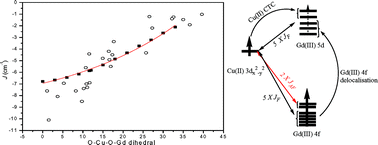Density functional studies on the exchange interaction of a dinuclear Gd(iii)–Cu(ii) complex: method assessment, magnetic coupling mechanism and magneto-structural correlations†
Abstract
Density functional calculations have been performed on a [Gd(III)Cu(II)] complex [L1CuGd(O2CCF3)3(C2H5OH)2] (1) (where L1 is N,N′-bis(3-ethoxy-salicylidene)-1,2-diamino-2-methylpropanato) with an aim of assessing a suitable functional within the DFT formalism to understand the mechanism of magnetic coupling and also to develop magneto-structural correlations. Encouraging results have been obtained in our studies where the application of B3LYP on the crystal structure of 1 yields a ferromagnetic J value of −5.8 cm−1 which is in excellent agreement with the experimental value of −4.42 cm−1 (Ĥ = JŜGd·ŜCu). After testing varieties of functional for the method assessment we recommend the use of B3LYP with a combination of an effective core potential basis set. For all electron basis sets the relativistic effects should be incorporated either via the Douglas–Kroll–Hess (DKH) or zeroth-order regular approximation (ZORA) methods. A breakdown approach has been adopted where the calculations on several model complexes of 1 have been performed. Their wave functions have been analysed thereafter (MO and NBO analysis) in order to gain some insight into the coupling mechanism. The results suggest, unambiguously, that the empty Gd(III) 5d orbitals have a prominent role on the magnetic coupling. These 5d orbitals gain partial occupancy viaCu(II) charge transfer as well as from the Gd(III) 4f orbitals. A competing 4f–3d interaction associated with the symmetry of the complex has also been observed. The general mechanism hence incorporates both contributions and sets forth rather a prevailing mechanism for the 3d–4f coupling. The magneto-structural correlations reveal that there is no unique parameter which the J values are strongly correlated with, but an exponential relation to the J value found for the O–Cu–O–Gd dihedral angle parameter is the most credible correlation.


 Please wait while we load your content...
Please wait while we load your content...